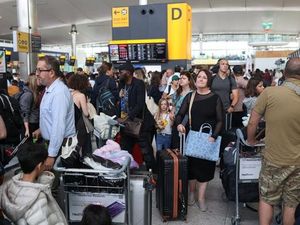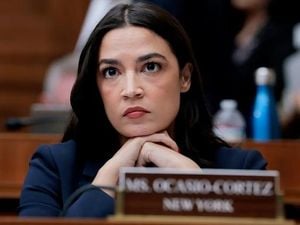Tempers are flaring on both coasts and across the internet after a deadly crash in Florida left three people dead and set off a political and cultural firestorm over immigration, public safety, and the American justice system. The incident, which took place on August 12, 2025, in St. Lucie County, Florida, involved Harjinder Singh, a 28-year-old Indian national who entered the United States illegally in 2018 and later obtained a commercial driver’s license in California. According to Fox News Digital, Florida’s Lieutenant Governor Jay Collins has placed the blame for the tragedy squarely on California Governor Gavin Newsom, igniting a war of words between the two states.
Lt. Gov. Collins, a former Tampa state senator and retired Green Beret who lost his leg in the War on Terror, didn’t mince words as he prepared to return to Tallahassee with Singh in custody. “Three lives lost because of Gavin Newsom, because of California's failed policies. We're done with that s---,” Collins declared, as reported by Fox News Digital. He argued that lax enforcement and what he described as California’s permissive approach to undocumented immigrants allowed Singh to obtain a commercial driver’s license despite entering the country illegally and, according to Collins, demonstrating limited English proficiency. Collins claimed that when Singh was interrogated by the Florida Highway Patrol after the crash, he could only answer three out of sixteen questions correctly due to his lack of English skills.
Collins went further, framing the crash as symptomatic of broader systemic failures. “How many more lives have to be lost because of Gavin Newsom's failed policies? How many more lives have to be lost because of fentanyl, because of gangs, because of rampant disregard for American citizens?” he asked, as cited by Fox News Digital. He accused Newsom of caring more about social media than the safety of Californians and Americans at large, saying, “The fact of the matter is Gavin Newsom continues to care more about tweets and what goes out on social media than taking care of the American citizens and the citizens of California.”
In a dramatic twist, Collins traveled to California to retrieve Singh, a move he described as “not business as usual.” At a press conference at Stockton Airport, south of Sacramento, he told reporters, “This isn't politics as usual. I am not your run-of-the-mill lieutenant governor.” Collins, who has been dubbed “The Chuck Norris of Florida Politics” by Governor Ron DeSantis for his willingness to take on tough or dangerous assignments, added, “In the words of what I would say, some left-leaning Californians, I don't identify as a politician. I identify as a God-fearing, gun-loving, freedom-defending, one-legged, retired Green Beret.”
Governor Newsom’s team was quick to push back, taking to social media to counter Collins’s accusations. Newsom’s press office claimed that Florida authorities had let “a murder suspect walk,” and that it was California police who had to step in and arrest Singh. “So, let’s get this straight: Florida let a murder suspect walk, California police had to step in and arrest him and now Florida’s new LG is staging a photo op to pick him up?” said Diana Crofts-Pelayo, a Newsom spokeswoman, in comments to Fox News Digital. Newsom’s official X account went further, mocking Florida Governor Ron DeSantis and referencing the ongoing dispute over the Reedy Creek Improvement District, which governs the land on which Walt Disney World sits. “The guy who lost to Mickey Mouse is now proving that California’s so-called ‘sanctuary’ laws actually work. Thanks, Ron,” Crofts-Pelayo quipped.
As the political spat raged, a parallel drama was unfolding online. In the days following Singh’s arrest, a petition calling for his release went viral, amassing over 1.6 million signatures by August 24, 2025. The petition, as reported by India Today, describes the crash as “a tragic accident — not a deliberate act,” and argues, “While accountability matters, the severity of the charges against him does not align with the circumstances of the incident.” This groundswell of support has largely come from the Punjabi diaspora and others sympathetic to Singh’s plight.
But the petition has triggered a fierce backlash, especially among conservative commentators and social media users. Outlets like Breitbart News amplified the story, with one post noting, “More than 1,600,000 people have signed an online petition attributed to ‘Punjabi youth’ urging the federal government to free Harjinder Singh.” The online discourse quickly turned heated, with some users demanding not only Singh’s deportation but also that of those supporting him. “He must be punished with the full force of the law and deported after the life sentence,” one user wrote, while another questioned, “What is wrong with this world? He is a 'professional driver' and performed an illegal manoeuvre that resulted in the deaths of 3 American citizens... Absolutely ridiculous that anyone believes he shouldn't be appropriately punished for his actions.”
The controversy has also inspired counter-petitions, some of which call for the deportation of those who signed the original petition for Singh’s release. One such counter-petition, as cited by India Today, reads, “These signatories not only undermine the legal system but also pose a potential threat to public safety by advocating leniency for someone whose actions led to irreversible consequences. It's crucial that our country sends a clear message: we will not tolerate such recklessness, nor will we shelter those who support it.”
The fallout from the crash has not been limited to petitions and political grandstanding. In the wake of the tragedy, the U.S. government announced a pause on issuing worker visas for commercial truck drivers, a move that has sent ripples through the transportation industry and added fuel to the ongoing debate over immigration and labor policy.
At its core, the story of Harjinder Singh and the St. Lucie County crash is about more than just a single tragic incident. It has become a flashpoint in the national conversation about immigration, public safety, and the responsibilities of government at every level. For some, Singh is a scapegoat for broader systemic failures; for others, he is a symbol of the dangers posed by what they see as lax enforcement and permissive policies. As the investigations and court proceedings continue, both the victims’ families and millions of onlookers will be watching closely, searching for justice, accountability, and perhaps some measure of closure.
With passions running high and political leaders trading barbs, the aftermath of this fatal crash has become a microcosm of the broader debates roiling American society in 2025. The questions it raises—about law, empathy, and the limits of forgiveness—are unlikely to fade any time soon.




